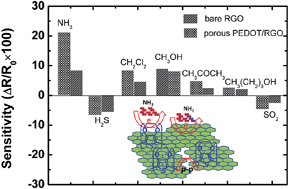Porous conducting polymer and reduced graphene oxide nanocomposites for room temperature gas detection
Abstract
We report the chemical in situ deposition of a porous conducting polymer poly(3,4-ethylenedioxythiophene) (PEDOT) on reduced graphene oxide (RGO) film as an efficient chemiresistor sensor platform for room temperature NH3 gas detection. A good covering of porous PEDOT on RGO was achieved through a simple baking treatment during the in situ polymerization of PEDOT. The good covering of porous PEDOT on the RGO surface was confirmed by SEM, UV-Vis spectra, and FT-IR spectra methods. The gas sensing performance revealed that, in contrast to bare RGO and common PEDOT, the porous PEDOT/RGO based gas sensor exhibited an obvious sensitivity enhancement as well as response/recovery performance. The large surface area and very open structure of the porous PEDOT resulted in an excellent synergistic effect between PEDOT and RGO during the gas sensing process. As a result of the uniform distribution of the PEDOT porous network on the RGO sheets, this nanocomposite based sensor also exhibited higher selectivity to NH3 in contrast to other reductive analyte gases.


 Please wait while we load your content...
Please wait while we load your content...